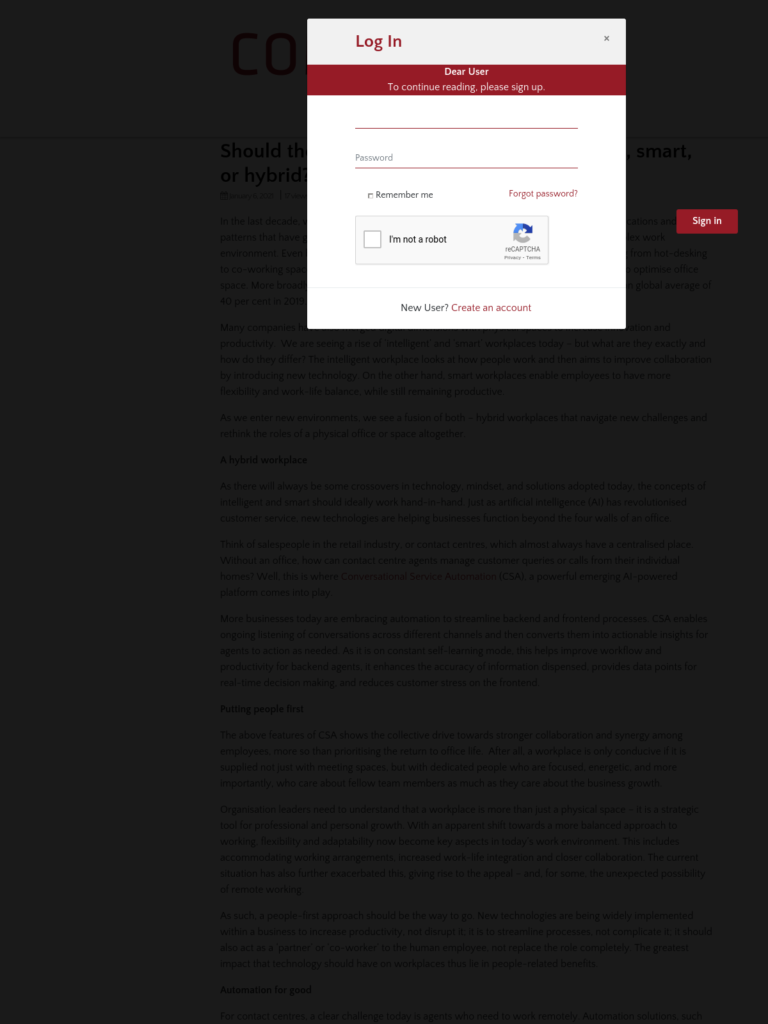Should the future contact centre be intelligent, smart, or hybrid?
Blog: NASSCOM Official Blog
In the last decade, workplaces have undergone substantial changes with new work styles, locations and patterns that have given rise to a better connected, more competitive and increasingly complex work environment. Even before the global pandemic, businesses adopted fresher ways of working from hot-desking to co-working spaces. Organisations have been exploring the hot-desking trend since 2017 to optimise office space. More broadly, Asia Pacific memberships of co-working spaces have grown higher than global average of 40 per cent in 2019.
Many companies have also merged digital dimensions with physical spaces to increase innovation and productivity. We are seeing a rise of ‘intelligent’ and ‘smart’ workplaces today – but what are they exactly and how do they differ? The intelligent workplace looks at how people work and then aims to improve collaboration by introducing new technology. On the other hand, smart workplaces enable employees to have more flexibility and work-life balance, while still remaining productive.
As we enter new environments, we see a fusion of both – hybrid workplaces that navigate new challenges and rethink the roles of a physical office or space altogether.
A hybrid workplace
As there will always be some crossovers in technology, mindset, and solutions adopted today, the concepts of intelligent and smart should ideally work hand-in-hand. Just as artificial intelligence (AI) has revolutionised customer service, new technologies are helping businesses function beyond the four walls of an office.
Think of salespeople in the retail industry, or contact centres, which almost always have a centralised place. Without an office, how can contact centre agents manage customer queries or calls from their individual homes? Well, this is where Conversational Service Automation (CSA), a powerful emerging AI-powered platform comes into play.
More businesses today are embracing automation to streamline backend and frontend processes. CSA enables ongoing listening of conversations across different channels and then converts them into actionable insights for agents to action as needed. As it is on constant self-learning mode, this helps improve workflow and productivity for backend agents, it enhances the accuracy of information dispensed, provides data points for real-time decision making, and reduces customer stress on the frontend.
Putting people first
The above features of CSA shows the collective drive towards stronger collaboration and synergy among employees, more so than prioritising the return to office life. After all, a workplace is only conducive if it is supplied not just with meeting spaces, but with dedicated people who are focused, energetic, and more importantly, who care about fellow team members as much as they care about the business growth.
Organisation leaders need to understand that a workplace is more than just a physical space – it is a strategic tool for professional and personal growth. With an apparent shift towards a more balanced approach to working, flexibility and adaptability now become key aspects in today’s work environment. This includes accommodating working arrangements, increased work-life integration and closer collaboration. The current situation has also further exacerbated this, giving rise to the appeal – and, for some, the unexpected possibility of remote working.
As such, a people-first approach should be the way to go. New technologies are being widely implemented within a business to increase productivity, not disrupt it; it is to streamline processes, not complicate it; it should also act as a ‘partner’ or ‘co-worker’ to the human employee, not replace the role completely. The greatest impact that technology should have on workplaces thus lie in people-related benefits.
Automation for good
For contact centres, a clear challenge today is agents who need to work remotely. Automation solutions, such as CSA, can make it easy to run call centres from virtually anywhere and ace customer service. Employers are also able to monitor every interaction to assess compliance and quality. Moreover, if a business is forced to limit in-person contact, they can rely on CSA to handle queries and effectively serve their customers any time of the day or night. This ensures that the business does not suffer downtime due to lack of manpower, and helps alleviate the strain on management with current realities.
Contact centre agents can also better cope with the stresses of uncertainty and massive changes to their working arrangements. These technologies are equipped to understand unique challenges and help agents during this challenging time through coaching and training. CSA can accelerate modern collaboration and assist the transformation of how employees, customers, and things connect.
All in all, the objective of a workplace has not changed – it is designed to connect employees and customers in a seamless and secure way, regardless of their location or device. Of course, there is no one-size-fits-all solution. What works for some may not work for others, especially if a business has employees based in different geographical locations. As such, it is crucial to put people first and allow technology to help the business enhance productivity and efficiency – a hybrid workplace could very well be the solution businesses need today. As a leader, I see more possibilities today than ever, as people start to embrace new approaches and outlooks as to what a workplace means, and can be, for them.
The article was first published on FutureCIO
By Ravi Saraogi, Co-founder and President of Asia Pacific, Uniphore
The post Should the future contact centre be intelligent, smart, or hybrid? appeared first on NASSCOM Community |The Official Community of Indian IT Industry.
Leave a Comment
You must be logged in to post a comment.








